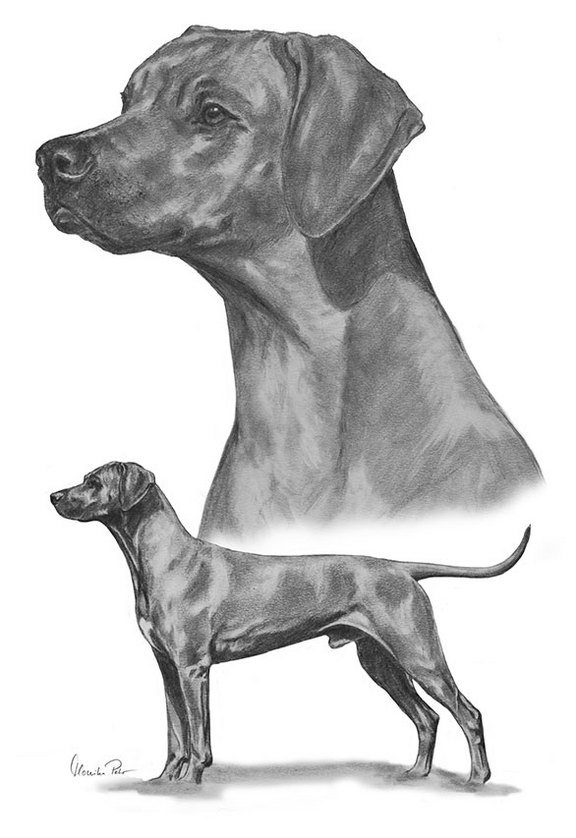Breed standard Lionhound

ORIGIN: Germany
DATE OF THE PUBLICATION OF THE OFFICIAL VALID STANDARD: 18.08.2025
Note: Standard created based on the Rhodesian Ridgeback Standard by Monika Pehr
UTILIZATION
Family dog, companion dog and for various other purposes such as hunting and mantrailing
FCI CLASSIFICATION (Breed not recognized by FCI)
HISTORICAL BACKGROUND
The Lionhound breed originates from the Rhodesian Ridgeback, whose original standard was established by F.R. Barnes in 1922 in Bulawayo, Rhodesia, and recognized by the KUSA (Kennel Union of South Africa) in 1926. The ancestors of the Rhodesian Ridgeback can be traced back to the Cape Colony, where they interbred with both the dogs of the early pioneers as well as with the semi-domesticated Hottentot dogs, which had a ridge. This ridge is the distinctive characteristic of the Rhodesian Ridgeback.
GENERAL
The ridge mutation, which plays a major role in the Rhodesian Ridgeback, is unimportant in the Lionhound. A ridge is permitted, dogs with a ridge should generally only be bred to dogs without a ridge.
APPEARANCE
The Lionhound should be a well balanced, muscular, agile and active dog. He is capable of great endurance with a fair amount of speed.
The main focus is on agility, elegance and health without any tendency towards a massive appearance.
BEHAVIOUR / TEMPERAMENT
Dignified, intelligent, rather reserved towards strangers, but without signs of aggression or shyness.
HEAD
The skull should be of medium length, flat and broad between the ears. The width between the ears, the distance from the occiput to the stop and from the stop to tip of the nose should be equal. The head should not show any wrinkles in a relaxed position.
The Stop should be well defined, the profile should not be a straight line from the occipital bone to the nose.
The muzzle should be long, deep and powerful.
The lips should be clean and closely fitting the jaws.
The nose should be black or brown (livernose). A black nose should be accompanied by dark eyes, a brown nose by amber eyes.
The jaw should be strong and have no cheeks.
The bite should be a scissor bite with a perfect, complete scissor. This means that the upper incisors closely overlap the lower incisors and are set vertically in the jaw. The teeth must be well developed, especially the canines. A complete set of 42 teeth is desirable (according to the dental formula).
The eyes should be moderately well apart, round, bright and sparkling with intelligent expression. Their color should harmonising with the coat color.
The ears should be set rather high, of medium size, rather wide at the base, and gradually tapering to a rounded point. They should be carried close to the head.m Kopf anliegend getragen werden.
The neck should be fairly long, strong and free from troatiness.
BODY
The back should be powerful.
The loins should be strong, muscular and slightly arched.
The chest should not be too wide, but very deep and capacious, The lowest point of the brisket should be at elbow level.
The forechest should be visible when viewed from the side.
The ribs should be moderately well sprung, never rounded like barrel-hoops.
The tail should be strong at the root and gradually tapering towards the end. It should be of moderate length, set neither too high nor too low and carried with a slight curve upwards but never curled.
LIMBS
Forequarters
The forelegs should be perfectly straight, strong and well boned, with the elbows close to the body. When viewed from the side, the forelegs should be wider than viewed from the front.
The shoulders should be clearly defined, sloping and muscular
The pastern joints should be strong and the forefoot should be slightly inclined.
The forefeet should be compact and round, with well arched toes and tough, elastic pads, protected by hair between the toes and pads.
Hindquarters
The hindquarters should have clear, well-developed, lean muscles, the knees should be well angled and the hocks should set low.
The hind feet should be compact and round with well-arched toes and sturdy, elastic pads protected by hair between the toes and pads.
GAIT / MOVEMENT
With good reach and drive, active and free.
COAT
The coat should be short and dense, sleek and glossy in appearance, but neither woolly nor silky.
The color is light wheaten to red wheaten with a black nose or a brown nose (livernose).
White on the chest and feet is permitted, as are dark muzzles and dark ears. Scattered black hair on head, neck and tail is acceptable.
SIZE
The desired withers heights are:
Dogs: 63 - 69 cm
Bitches: 61 cm - 67 cm
Harmoniously built dogs of perfect type should not be penalized if their height at the withers exceeds or falls below the above-mentioned limit.
FAULTS
Departures from the foregoing points should be considered a fault and the seriousness with which the fault should be regarded should be in exact proportion to its degree.
Priority has the health and welfare of the dog which means, that a cosmetic departures from the standard, which in no way affect it, are of secondary importance.
DISQUALIFYING FAULTS
• Aggressive or overly shy dog
• Dogs who clearly show physical abnormalities or behavioural disorders
N.B.:
• Male animals should have two apparently normal testicles fully descended in to the scrotum
• Only functionally and clinically healthy dogs, with breed-typical conformations should be used for breeding
